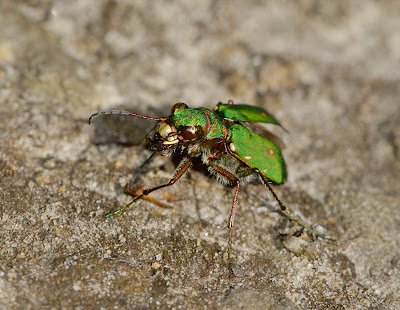I went to Sheffield to visit some friends and made a trip to Wharncliffe Heath with Richard, to look for Nightjars (Caprimulgus europaeus) and bats (I got a loan of a heterodyne bat detector!).
Wharncliffe Heath is a VERY small area of heathland (about the size of a large field) with oaks dotted through it. The surrounding area is a patchwork of old oak/birch woodland (with lots of bluebells) and sheep fields. We walked through the woodlands from the Wharncliffe Arms, in the direction of the Wharncliffe Crags. The woodland was full of Speckled Woods (Pararge aegeria) and some were landing on muddy river banks to drink. Green-veined Whites (Pieris napi) were also on the wing and we found a rather ragged-looking Peacock butterfly (Inachis io).
Wharncliffe Heath is a VERY small area of heathland (about the size of a large field) with oaks dotted through it. The surrounding area is a patchwork of old oak/birch woodland (with lots of bluebells) and sheep fields. We walked through the woodlands from the Wharncliffe Arms, in the direction of the Wharncliffe Crags. The woodland was full of Speckled Woods (Pararge aegeria) and some were landing on muddy river banks to drink. Green-veined Whites (Pieris napi) were also on the wing and we found a rather ragged-looking Peacock butterfly (Inachis io).
 |
| Peacock (Inachis io) |
The Wharncliffe Crags are popular with rock-climbers and are very dramatic. The rocks were baking hot, so we sat in the shade of the trees to eat our lunch.
 |
| Wharncliffe Crags |
 |
| Sessile Oak (Quercus petraea) |
There were lots of Green Tiger Beetles (Cicindela campestris) hurriedly scurrying along the sandy path ahead of us.
 |
| Green Tiger Beetle (Cicindela campestris) |
 |
| Green Tiger Beetle (Cicindela campestris) mating pair |
We walked over the sheep fields as we had time to kill before dusk. Perching on a dry stone wall there was a plump Red-legged Partridge (Alectoris rufa).

Once the fiery-orange sunset had faded, we began doing a circuit of the heath with the bat detector switched on. After about 30 minutes we began hearing our first bats! The sound they emitted was like a sputtering, wet-slapping, clicking sound. It took us awhile to get the hang of using the bat detector - estimating the frequency peak and range was difficult. The bats we heard were definitely one of three Pipistrelle species: Common Pipistrelle, Nathusius' Pipistrelle or Soprano Pipistrelle.
In the half-light we could see Woodcock (Scolopax rusticola) circling above our heads and uttering 'tssick tssick!'. This shy bird is an unusual species of wader (Scolopacidae): being both a woodland species and nocturnal.
Soon the sky became pitch-black and we took our torches out. We waited until 10:30pm and then, just as we were thinking about heading home, we heard our first Nightjar! At first the churring was intermittent and seemed to be a single Nightjar but after awhile the churring was coming from several directions. We walked in the direction of the nearest churring but, in a grasshopper-like fashion, the churring stopped as soon as we came close and restarted again further away! Chasing nightjars in the dark is like following will o' the wisps!
It was impossible to work out which path we had taken through the forest as there were so many unmarked intercrossing paths on the map. The path we chose took us a longer route and we ended up walking along the side of the railway line, looking for the crossing which would save us time and allow us to catch the last bus home. Walking through the rough gravel took ages and eventually we had to concede defeat and we scrambled up the side of a railway bridge into Oughtibridge, where we phoned for a taxi outside The Cock Inn (feeling like prank-callers!).









